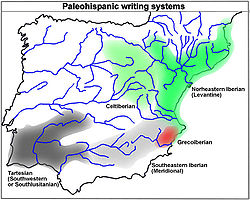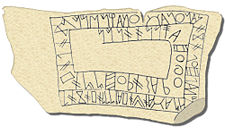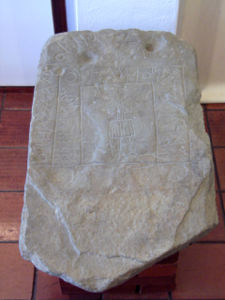
Southwest script
Encyclopedia

.jpg)


Paleohispanic scripts
The Paleohispanic scripts are the writing systems created in the Iberian peninsula before the Latin alphabet became the dominant script...
used to write an unknown language usually identified as Tartessian
Tartessian language
The Tartessian language is the extinct Paleohispanic language of inscriptions in the Southwestern script found in the southwest of the Iberian Peninsula: mainly in the south of Portugal , but also in Spain . There are 95 of these inscriptions with the longest having 82 readable signs...
. Southwest inscriptions have been found mainly in the southwestern quadrant of the Iberian Peninsula
Iberian Peninsula
The Iberian Peninsula , sometimes called Iberia, is located in the extreme southwest of Europe and includes the modern-day sovereign states of Spain, Portugal and Andorra, as well as the British Overseas Territory of Gibraltar...
, in the south of Portugal
Portugal
Portugal , officially the Portuguese Republic is a country situated in southwestern Europe on the Iberian Peninsula. Portugal is the westernmost country of Europe, and is bordered by the Atlantic Ocean to the West and South and by Spain to the North and East. The Atlantic archipelagos of the...
(Algarve and southern Alentejo), but also in Spain
Spain
Spain , officially the Kingdom of Spain languages]] under the European Charter for Regional or Minority Languages. In each of these, Spain's official name is as follows:;;;;;;), is a country and member state of the European Union located in southwestern Europe on the Iberian Peninsula...
, in southern Extremadura
Extremadura
Extremadura is an autonomous community of western Spain whose capital city is Mérida. Its component provinces are Cáceres and Badajoz. It is bordered by Portugal to the west...
and western Andalucia.
Name of the script
The name of this script is very controversial. The more neutral name is southwestern, because it refers only to the geographical location where the inscriptions had been found, but it needs some additional precision in a general context. Some researchers name this script TartessianTartessian
Tertessian may refer to:*an ancient civilization based in Tartessos in modern-day Andalusia*the Tartessian language*the Tartessian script...
considering this script the script of Tartessos
Tartessos
Tartessos or Tartessus was a harbor city and surrounding culture on the south coast of the Iberian peninsula , at the mouth of the Guadalquivir River. It appears in sources from Greece and the Near East starting in the middle of the first millennium BC, for example Herodotus, who describes it as...
. Others prefer to name this script as South Lusitanian, because almost all the southwestern inscriptions have been found in the south of Portugal (an area included in the Roman province
Roman province
In Ancient Rome, a province was the basic, and, until the Tetrarchy , largest territorial and administrative unit of the empire's territorial possessions outside of Italy...
of Lusitania
Lusitania
Lusitania or Hispania Lusitania was an ancient Roman province including approximately all of modern Portugal south of the Douro river and part of modern Spain . It was named after the Lusitani or Lusitanian people...
), where the Greek
Ancient Greece
Ancient Greece is a civilization belonging to a period of Greek history that lasted from the Archaic period of the 8th to 6th centuries BC to the end of antiquity. Immediately following this period was the beginning of the Early Middle Ages and the Byzantine era. Included in Ancient Greece is the...
and Roman
Ancient Rome
Ancient Rome was a thriving civilization that grew on the Italian Peninsula as early as the 8th century BC. Located along the Mediterranean Sea and centered on the city of Rome, it expanded to one of the largest empires in the ancient world....
sources locate the Pre-Roman
Pre-Roman peoples of the Iberian Peninsula
This is a list of the Pre-Roman peoples of the Iberian peninsula .-Non-Indo-European:*Aquitanians**Aquitani**Autrigones - some consider them Celtic .**Caristii - some consider them Celtic ....
Conii or Cynetes
Cynetes
The Cynetes or Conii were one of the pre-Roman peoples of the Iberian Peninsula, living in today's Algarve and Low Alentejo regions of southern Portugal before the 6th century BCE .They are often mentioned in the ancient sources under various designations, mostly Greek or Latin derivatives of their...
people, instead in the zone generally considered Tartessian (between Huelva
Huelva
Huelva is a city in southwestern Spain, the capital of the province of Huelva in the autonomous region of Andalusia. It is located along the Gulf of Cadiz coast, at the confluence of the Odiel and Tinto rivers. According to the 2010 census, the city has a population of 149,410 inhabitants. The...
and the Guadalquivir
Guadalquivir
The Guadalquivir is the fifth longest river in the Iberian peninsula and the second longest river to be its whole length in Spain. The Guadalquivir is 657 kilometers long and drains an area of about 58,000 square kilometers...
valley). But on the other hand, the name South Lusitanian is inconvenient, as it may wrongly suggest a relation with the Lusitanian language
Lusitanian language
Lusitanian was a paleohispanic language that apparently belonged to the Indo-European family. Its relationship to the Celtic languages of the Iberian Peninsula, either as a member, a cousin , or as a different branch of Indo-European, is debated. It is known from only five inscriptions, dated from...
. Other name proposals include Bastulo-Turdetani
Turdetani
The Turdetani were ancient people of the Iberian peninsula , living in the valley of the Guadalquivir in what was to become the Roman Province of Hispania Baetica...
an and Algarvan.
Writing system
Excepting the Greco-Iberian alphabetGreco-Iberian alphabet
The Greco-Iberian alphabet is a direct adaptation of an Ionic variant of a Greek alphabet to the specifics of the Iberian language, thus this script is an alphabet and lacks the distinctive characteristic of the rest of paleohispanic scripts that present signs with syllabic value, for the...
, and to a lesser extent this script, paleohispanic scripts
Paleohispanic scripts
The Paleohispanic scripts are the writing systems created in the Iberian peninsula before the Latin alphabet became the dominant script...
shared a distinctive typology: They behaved as a syllabary
Syllabary
A syllabary is a set of written symbols that represent syllables, which make up words. In a syllabary, there is no systematic similarity between the symbols which represent syllables with the same consonant or vowel...
for the stop consonant
Stop consonant
In phonetics, a plosive, also known as an occlusive or an oral stop, is a stop consonant in which the vocal tract is blocked so that all airflow ceases. The occlusion may be done with the tongue , lips , and &...
s and as an alphabet
Alphabet
An alphabet is a standard set of letters—basic written symbols or graphemes—each of which represents a phoneme in a spoken language, either as it exists now or as it was in the past. There are other systems, such as logographies, in which each character represents a word, morpheme, or semantic...
for the remaining consonants and vowels. This unique writing system
Writing system
A writing system is a symbolic system used to represent elements or statements expressible in language.-General properties:Writing systems are distinguished from other possible symbolic communication systems in that the reader must usually understand something of the associated spoken language to...
has been called a semi-syllabary
Semi-syllabary
A semi-syllabary is a writing system that behaves partly as an alphabet and partly as a syllabary. The term has traditionally been extended to abugidas, but for the purposes of this article it will be restricted to scripts where some letters are alphabetic and others are syllabic.-Iberian...
. There is no agreement about how the paleohispanic semi-syllabaries originated; some researchers conclude that their origin is linked only to the Phoenician alphabet
Phoenician alphabet
The Phoenician alphabet, called by convention the Proto-Canaanite alphabet for inscriptions older than around 1050 BC, was a non-pictographic consonantal alphabet, or abjad. It was used for the writing of Phoenician, a Northern Semitic language, used by the civilization of Phoenicia...
, while others believe the Greek alphabet
Greek alphabet
The Greek alphabet is the script that has been used to write the Greek language since at least 730 BC . The alphabet in its classical and modern form consists of 24 letters ordered in sequence from alpha to omega...
had also participated. In the southwestern script, although the letter used to write a stop consonant was determined by the following vowel, as in a full semi-syllabary, the following vowel was also written, as in an alphabet. Some scholars treat Tartessian as a redundant semi-syllabary, others treat it as a redundant alphabet.
The southwestern script is very similar to the southeastern Iberian script
Southeastern Iberian script
The southeastern Iberian script, also known as Meridional Iberian, was one of the means of written expression of the Iberian language, which was written mainly in the northeastern Iberian script and residually by the Greco-Iberian alphabet...
, both considering the shape of the signs or his value. The main difference is that southeastern Iberian script doesn’t show the vocalic redundancy of the syllabic signs. This characteristic was discovered by Ulrich Schmoll and allows the classification of a great part of the southwestern signs in vowel
Vowel
In phonetics, a vowel is a sound in spoken language, such as English ah! or oh! , pronounced with an open vocal tract so that there is no build-up of air pressure at any point above the glottis. This contrasts with consonants, such as English sh! , where there is a constriction or closure at some...
s, consonant
Consonant
In articulatory phonetics, a consonant is a speech sound that is articulated with complete or partial closure of the vocal tract. Examples are , pronounced with the lips; , pronounced with the front of the tongue; , pronounced with the back of the tongue; , pronounced in the throat; and ,...
s and syllabic signs. Unlike the northeastern Iberian script
Northeastern Iberian script
The northeastern Iberian script is also known as Levantine Iberian or Iberian, because it is the Iberian script that was most frequently used, and was the main means of written expression of the Iberian language. The language is also expressed by the southeastern Iberian script and by the...
the decipherment of the southeastern Iberian script and the southwestern script is not still closed, because there are a significant group of signs without consensus value.
Inscriptions
This script is almost exclusively used in near a hundred large stones (steleStele
A stele , also stela , is a stone or wooden slab, generally taller than it is wide, erected for funerals or commemorative purposes, most usually decorated with the names and titles of the deceased or living — inscribed, carved in relief , or painted onto the slab...
s), probably with funerary purpose. Almost always the direction of the writing is right to left, but also boustrophedon
Boustrophedon
Boustrophedon , is a type of bi-directional text, mostly seen in ancient manuscripts and other inscriptions. Every other line of writing is flipped or reversed, with reversed letters. Rather than going left-to-right as in modern English, or right-to-left as in Arabic and Hebrew, alternate lines in...
or spiral
Spiral
In mathematics, a spiral is a curve which emanates from a central point, getting progressively farther away as it revolves around the point.-Spiral or helix:...
. The fact that almost all the southwestern inscriptions had been found out of archaeological context does not permit fixing a precise chronology, but it seems clear that it was used in the 5th century BC; however it is usual to date them from the 7th century BC and consider that the southwestern script is the most ancient paleohispanic script.
A total of 75 southwest script stelae are known. Of these, 16 can be seen in the Southwest Script Museum (Museu da Escrita do Sudoeste, in Portuguese
Portuguese language
Portuguese is a Romance language that arose in the medieval Kingdom of Galicia, nowadays Galicia and Northern Portugal. The southern part of the Kingdom of Galicia became independent as the County of Portugal in 1095...
), in Almodôvar
Almodôvar
Almodôvar is a municipality in Portugal with a total area of 777.9 km² and a total population of 7,650 inhabitants. The municipality is composed of 8 parishes, and is located in the District of Beja....
(Portugal), where a recently discovered stele with a total of 86 characters (the longest inscription found so far) will also be on display.
See also
- Espanca scriptEspanca scriptThe Espança script is the only complete signary known of the Paleohispanic scripts. It is inscribed on a piece of slate, 48×28×2 cm. This alphabet consists of 27 letters written double...
- Pre-Roman peoples of the Iberian PeninsulaPre-Roman peoples of the Iberian PeninsulaThis is a list of the Pre-Roman peoples of the Iberian peninsula .-Non-Indo-European:*Aquitanians**Aquitani**Autrigones - some consider them Celtic .**Caristii - some consider them Celtic ....
- Prehistoric IberiaPrehistoric IberiaThe prehistory of the Iberian peninsula begins with the arrival of the first hominins 1.2 million years ago and ends with the Punic Wars, when the territory enters the domains of written history...
- Timeline of Portuguese historyTimeline of Portuguese historyThis is a historical timeline of Portugal.*Timeline of Iberian prehistory*Pre-Roman Iberia *Roman Lusitania and Gallaecia *Germanic Kingdoms...
- Timeline of Iberian prehistory
- Timeline of pre-Roman Iberian history (before the 3rd century BC)Timeline of pre-Roman Iberian historyThis section of the timeline of Iberian history concerns events from before the Carthaginian conquests .-Bronze Age:*2nd millennium BC** c. 1800 BC – The El Argar civilization appears in Almería, south-east of Spain, replacing the earlier civilization of Los Millares. The adoption of bronze...
- Timeline of Portuguese history: Roman Lusitania and Gallaecia (3rd century BC to 4th century AD)Timeline of Portuguese history (Lusitania and Gallaecia)This is a historical timeline of Portugal.-3rd century BC:*237 BC - The Carthaginian General Hamilcar Barca enters Iberia with his armies through Gadir.*228 BC - Hamilcar Barca dies in battle...

